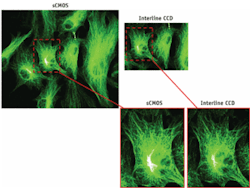BIOINSTRUMENTATION: Laser, World of Photonics focuses on bio
Bio applications were a major emphasis at the enormous biennial Laser, World of Photonics 2009 (June 15-18, 2009; Munich, Germany), with an exhibition area dedicated mainly to biomedical exhibits. An open theater in the hall–through which most traffic passed to reach the other three halls–hosted a number of bio-focused presentations that augmented the paper presentations in the formal Congress. Beside it, a large exhibit by the Biophotonics Research Program, a national effort backed by the German Federal Ministry of Education and Research, highlighted the results of cooperative research and product development among researchers and equipment suppliers based on the needs of end users.
The plenary session featured Jerome Mertz of Boston University (Boston, MA), who discussed techniques for out-of-focus background rejection in optical microscopy, and Vasilis Ntziachristos of the Institute for Biological and Medical Imaging, Helmholtz Zentrum (Munich, Germany), who shared results of research on combining optical and ultrasound techniques for emerging mesoscopic and macroscopic imaging. In fact, photoacoustics was a major theme in the Congress, as was optical coherence tomography (OCT).
An exciting announcement by a trio of commercial vendors–Andor Technology (Belfast, Northern Ireland), Fairchild Imaging (Milpitas, CA) and PCO (Kelheim, Germany) introduced–scientific CMOS (sCMOS), a new image sensing technology that promises particular benefit for a wide range of bio applications including live-cell and super-resolution microscopy, single-molecule detection, fluorescence spectroscopy, and genome sequencing. The technology is capable of simultaneously offering extremely low noise, rapid frame rates, wide dynamic range, high quantum efficiency (QE), high resolution, and a large field of view–unlike previous generations of CMOS and CCD-based sensors. Each of the companies plans its own products based on the technology; a prototype bioimaging system was on display in Andor’s booth.
Coherent (Santa Clara, CA) held a press conference to introduce several products for the biomedical space. The company has redesigned its Chameleon OPO (optical parametric oscillator) to provide simple access to tunable near-IR wavelengths for multiphoton-excitation (MPE) microscopy in combination with any Coherent Chameleon ultrafast lasers.
Two new Coherent lasers promise the highest power yet available in a compact package: the Sapphire 488 LP (150 mW of CW output at 488 nm), and the Sapphire 561 LP (200 mW of power at 561 nm) are targeted at applications such as flow cytometry, confocal microscopy, and sequencing in genomics and proteomics. The Genesis 355-150 S sets a power record for true CW ultraviolet solid-state performance, according to Coherent, delivering more than 50 mW of TEM00 output for flow cytometry and other live-cell bio applications. And two new Genesis CW green (532 nm) lasers offer a favorable combination of noise (< 0.1% rms) and mode quality (M2 <1.1); primary applications are fluorescence- based bioinstrumentation. Finally, Coherent has further expanded its OPSL platform with the Verdi G2 and G5 lasers, which deliver 2 and 5 W (respectively) at 532 nm; primary scientific applications include spectroscopy and holography.
About the Author

Barbara Gefvert
Editor-in-Chief, BioOptics World (2008-2020)
Barbara G. Gefvert has been a science and technology editor and writer since 1987, and served as editor in chief on multiple publications, including Sensors magazine for nearly a decade.
